When it comes to decision-making on how to choose a kayak, it can be close to impossible especially if you are a beginner.
This is especially true because there is such a large variety of types, supplies, and specific features of protection that you could easily scratch your head on where to start.
Whether one is planning on going out for a recreational paddle on flat water or going through some class III or IV rapids, the kind of kayak one uses determines a lot about the fun and safety of the knowledge on the water.
This guide will not only introduce you to some of the best programs out there, it will also show you how to choose one that will be best for your situation.

Know Your Purpose: What Type of Kayaking Are You Doing?

Before going deep into the differences between the different types of kayaks, the reader has to define what he intends to do with the kayak. These will define many of your options. Here are some widespread types of kayaking:
Recreational Kayaking
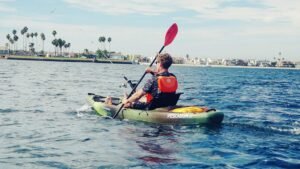
Most suitable for large and shallow still waters of continental shelves, sheltered sea areas, and some large slow-flowing river floodplains.
These kayaks are usually more stable and easily maneuverable, and, as such, are preferred for use by beginning and even intermediate paddlers.
Touring/Sea Kayaking

Built for extended use and activities that occur in areas with no boundaries of sea or lakeshore. Usually, they are longer, thinner, and provide better planning – more speed and a better ability to maintain that speed.
Whitewater Kayaking

Built for use where there are waves and the boat will be moving fast through the water. These are shorter and more responsive compared to the traditional ones, this gives the paddler a chance to manoeuvre through the rocks and other abnormalities in water.
Fishing Kayaking

Designed for the fishing enthusiast these kayaks come with accessories such as a holder for fishing rods, and storage for fishing tackles besides providing comfort for long hours on the water.
Understanding your purpose is important in that it assists one in filtering through the pack and settling for that particular type of kayak.
Consider the Material: Weight, Durability, and Price
Different types of materials are used to make a kayak and all of them have merits and demerits. Here’s a breakdown of the most mutual kayak materials:
Polyethene Plastic
Polyethene is the most economical of them all, though quite rugged and firm to impacts. They are heavier and can also wear out after some time if they are exposed to the natural rays of the sun or UV light.
ABS Plastic
ABS kayaks are a bit lighter compared to polyethene models, in addition to making better UV protection. They also cost more and are well-suited in terms of rigidity to weight.
Composite Materials (Fiberglass, Carbon Fiber)
These kayaks are somehow lighter in terms of weight and have some level of speed and manoeuvrability than others. But they are also the most costly and may also be more sensitive to impacts and shocks than the other types.
The type of material used will be influenced by your budget, the type of kayaking that you intend to be involved in and the frequency at which you are likely to be moving your kayak.
Kayak Size: Length and Width Matter

They are the length and the width of the kayak and in determining the suitability of sizes of the kayak, length and width determine how the particular kayak will be in the water.
Length
In most cases, the longer kayaks paddle faster and will stay straight, which is why they are recommended for use in touring and sea kayaking.
Measuring an average of 17 feet in length, traditional sea kayaks provide directional stability and thus are optimal for sea touring while the shorter ones are about 9 feet long, and are best suited for whitewater or recreational use.
Width
Constant-width kayaks are again more stable and these kayaks is suitable for beginners or for those who go for stability rather than speed. Whereas the narrower ones offer greater speed of traversal they make the boat feel very shaky at times.
Sit-In vs. Sit-On-Top Kayaks: Which One Is Right for You?
There are two main styles of kayaks: This is complemented by other models such as sit-in and sit-on-top. Each of them has its benefits, therefore the choice in their favour will depend on subjective feelings and the conditions to which you are exposed all the time you spend kayaking.
Sit-In Kayaks
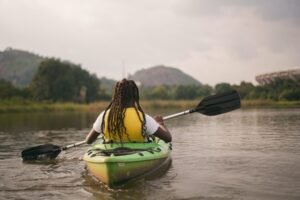
These are similar to the previous types, having a cockpit that is completely enclosed, and the sit-inside kind. They provide more shelter to the climate and are recommended for colder water or when there is wind.
But they can be rather restrictive and if you flip over, getting back in the kayak is not easy.
Sit-On-Top Kayaks
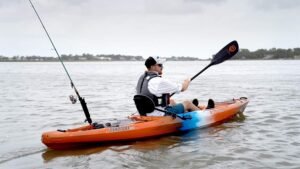
known as sit-on-top kayaks they are somewhat different from the normal kayaks in that you sit on the deck instead of in the hull.
They are not difficult to get on and off hence people who are learning to paddle or those people who occasionally paddle choose to use them. Indeed, the downside is you are exposed to all kinds of weather most of the time.
Weight Capacity: Don’t Overlook It
First, every kayak comes with its weight limit; the weight of the person who will be paddling it, and any items that he or she will be taking along with him or her.
Overloading your kayak may make you capsize and besides it will be difficult for you to control your kayak. It is also essential to look at the carrying capacity of the kayak that you will be choosing and it is essential if you are going to be carrying items like fishing gear, food and drinks among others.
Storage and Transport: How Will You Get Your Kayak to the Water?
There is also importance in how you want to transport and store your kayak when not in use because it will also determine its durability.
Folding kayaks can be quite large and weighty when folded hence consider where you will store it when not in use and how to transport it when going to use or when coming from the water. Considerations include:
- Weight: It will be noted that a somewhat heavier kayak may need to be pulled on a kayak cart or with help from a friend into the water.
- Size: Large ones cannot be taken inside small cars leaving you with no option than roofing your car or using a trailer to transport your equipment.
- Storage Space: Ensure that there is adequate space in the house to accommodate the kayak storage, it can be garage, shed or even in the compound.
Kayak Features: What’s Important to You?
There are many features you will find with a kayak, which will make your paddling to be interesting. Here are some key landscapes to consider:
- Seats: Being comfortable is important if one is to spend more time out in the water. Choose armless chairs with optional height and lumbar support, and good cushioning.
- Footrests: The seats are designed to be slid forward or backwards to set an optimal paddling position and increase the control over a kayak.
- Storage: If you are thinking of going for longer trips, or you are going to be carrying some equipment with you, then you should consider going for models which have compartments or spaces for storage such as hatches and deck rigging.
- Rod Holders and Mounts: Several things such as rod holders gear tracks, and tackle storage are invaluable in particularly if you indulge in kayak fishing.
- Skegs and Rudders: These are employed to enhance logging and management especially when there is considerable breeze. A skeg is a fixed fin, while a rudder is a movable fin controlled by foot pedals..
Essential Kayaking Accessories: Gear You Shouldn’t Paddle Without
The following are some of the accessories that you need when going for your kayaking trips; Here are some must-have kayak accessories:
Personal Flotation Device (PFD)

Being safe should be the number one thing that you should always consider. Models range from extremely comfortable to rigid, and the only ones you need are the ones that fit well when you’re on the water. Some of the PFDs are specifically made for kayaking to allow for more flexibility than the standard PFD.
Paddle
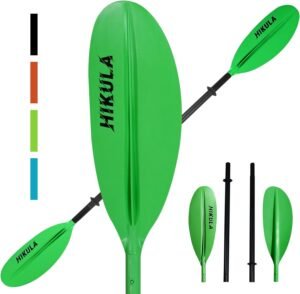
This might sound like common sense, arguably the selection of the paddle is even more important. The length of the paddle should compare to your height plus the width of your kayak. Comfort materials such as fibreglass or carbon fibre reduce fatigue on long journeys.
Dry Bag
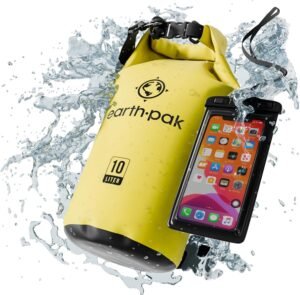
It is also necessary if you are on the road for a long time to preserve the personal effects of the moisture. A dry bag can be used to keep your phone, wallet, some snacks, or even extra clothes on the safe and dry side.
Spray Skirt
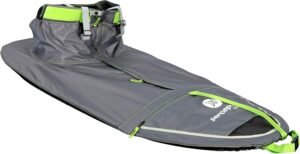
In the case of sit-in kayaks, the use of a spray skirt can be of added advantage particularly if one intends to kayak in the rough waters. It is of great aid in preventing the ingress of water into the cockpit thus protecting you from getting soaked and resultant hypothermia.
Paddle Leash
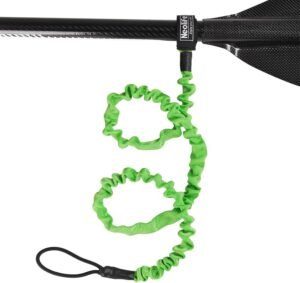
You will just wonder helplessly as your paddle floats on the water if you do not have a leash. This particular yet very useful item can help you avoid a lot of inconvenience.
Kayak Cart

A simple device that helps in moving a kayak from a vehicle to a water’s edge can be of help especially when the unit in use is very heavy or when the distance from the parking zone to the water body is long.
Anchor System
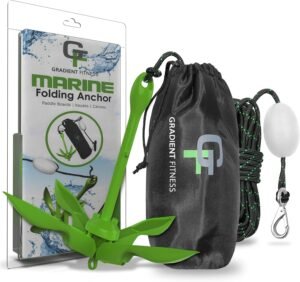
Originally used for kayak fishing we have come across that for those who partake in the activity or even those who just want to fish without floating an anchor is used to keep one in a place.
Safety Tips for Kayaking: Being Prepared on the Water
Experienced paddlers or not, it would be wise to stick with the offered kayaking safety tips to enjoy the ride. Here are some safety guidelines to keep in mind:
Check the Weather
Ensure you use weather-checking ways before going over the waterway. Water currents, winds and storms make it very risky to kayak particularly when one is not very experienced. It is advised not to paddle during noisy waters or when there is the likelihood of lightning.
Know the Water
Make yourself aware of the area of water that you will be using your canoe. It is important to know such parameters as rocks, falls or powerful streams, if they exist, and to choose a corresponding line.
Wear Your PFD
As much as you want to show people how great a swimmer you are, always wear your PFD. Stitches can be met at any time and a life jacket – is the thing that saves people’s lives.
Bring a First Aid Kit
Always have a small compact first aid kit ready preferably a waterproof one if you will be out for a long time. This can be useful just for simple cuts, bruises or as you may call it, injuries.
Stay Hydrated and Protect Yourself from the Sun
In his and her own way, both dehydration and sunburn are genuine dangers of hours on the water. As far as what you should do wear comfortable shoes because there is a lot of walking involved, bring lots of water and do carry sunscreen because trust me the sun is very hot; you might wish to carry a wide-brimmed hat and sunglasses.
Tell Someone Your Plans
In case you go out kayaking, ensure that you inform somebody concerning the area you intend to kayak and when you are likely to be back. This way, if something goes wrong, somebody is aware of, where you can be found at the time.
Building Your Kayaking Skills: Start Small and Progress Gradually
If you are a beginner kayaker, do not be in a hurry to go for the difficult terrains of water for your initial voyages. It is recommended that one begins gradually and increases his or her skill level.
Here are a few tips to help you progress:
Take a Class
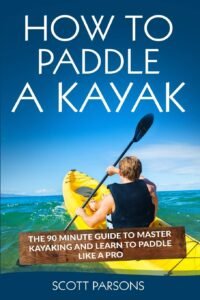
Some of the local companies engage in offering basic kayaking courses and they will take you through the acceptable paddling methods, precaution measures to take and how to operate your kayak depending on the conditions present.
Practice Self-Rescue Techniques
Another important thing that you as a kayaker should be aware of is how to fort up the kayak when you capsize. Swim in low-energy or clean flat water while learning different self-rescue skills as you prepare for a brutal environment.
Join a Kayaking Group
Kayak with others since it is more enjoyable and can be learned from more experienced people. Also, it has been stated that nothing in life is as good as going for a kayak ride with a friend, more so when it is a new area.
Experiment with Different Waters
With certainty, it is time to start getting experience and navigate kayaking in various conditions and locations, for example, rivers, lakes, and coastlines.
Both of them present their difficulties as well as opportunities and can contribute to making the person a more all-round paddler.
Environmentally Responsible Kayaking: Protecting the Waterways
The role of a kayaker is somewhat different, however, we have the main task of exploring nature and enjoying it. We therefore must ensure that those water correction channels and other natural features we enjoy are preserved.
Here are some tips for environmentally responsible kayaking:
- Leave No Trace: That which you have carried along with you: take it back with you. Always ensure that no litter is left behind and try as much as possible to have least interference to the environment.
- Respect Wildlife: However, do not take a closer look at the animals that you find on your kayaking expeditions because they can be startled easily. Bear in mind that you are on their territory or you are an intruder in their environment.
- Use Environmentally Friendly Products: Whichever cleaning process you use, ensure that you do it with biodegradable soaps, scents and other products that are friendly to the environment.
- Avoid Sensitive Areas: Pay great attention to areas known for the habitation of wildlife especially birds, and places that support extremely delicate environments like coral regions. Paddling should be done carefully or not in these areas to avoid damage.
Stability vs. Speed: Finding the Right Balance
One of the most obvious compromises, when it comes to selecting the right kayak, is the one between stability and speed. For novices or those whose mere objective is not to swim with the equipment, buoyancy is paramount.
Some models are a lot larger than others, still, and the larger ones are generally more stable which should give you a lot more confidence out on the water.
However, if someone is planning for long distances or using open water, speed comes into play. Tailable or narrower kayaks are usually faster but they can be a little tippy particularly if the intended user is a novice.
Budget: What’s the Best Kayak for Your Money?
There are cheap kayaks as well as expensive types of kayaks depending on the materials used. When choosing your budget you should take into consideration your usage frequency of the kayak and other features that is most vital to you. Here’s a general price breakdown:
Entry-Level: $200 – $500. These types of kayaks are normally made of polyethene plastic and can be recommended for the first-timer or the occasional paddler.
Mid-Range: $500 – $1,200. These kayaks are usually equipped with more features are made out of better materials and can perform better.
High-End: $1,200 and up. These are normally built from composites and they are for the serious paddlers who only want the very best in terms of performance and build quality.
Test Before You Buy: Try It on the Water
Last but not least, the final rule of selecting a kayak would be to take it for a trial on the water. Almost every kayak vendor –from brick-and-mortar stores to web-based stores– provides the opportunity for clients to try out different models through demo days. This enables you to feel the control of the kayak and the level of comfort provided and if it is what is needed.
Conclusion: How To Choose a Kayak
Deciding on the appropriate kayak to use should not be a very difficult decision to make. With regards to the kind of kayaking you prefer, the materials, designs and features that meet your needs as well as the amount of money that you are ready to spend you stand to secure the right kayak to take on your endeavours.
In calm water; on a shoreline or waters; in white waters, the choice of a kayak that you use will provide you with the joy of the advancement and fun that you have in the water.
Be patient, gather your information, and perhaps most of all: have fun! Happy paddling!
Buying a kayak and deciding on the kind of boat to get is not the end of the journey. That said, there are a few other issues that can help to improve your kayaking and make sure that you are all set before heading out for your next trip.
Here we present you useful information on how to look after your kayak and tips on what accessories you will need.

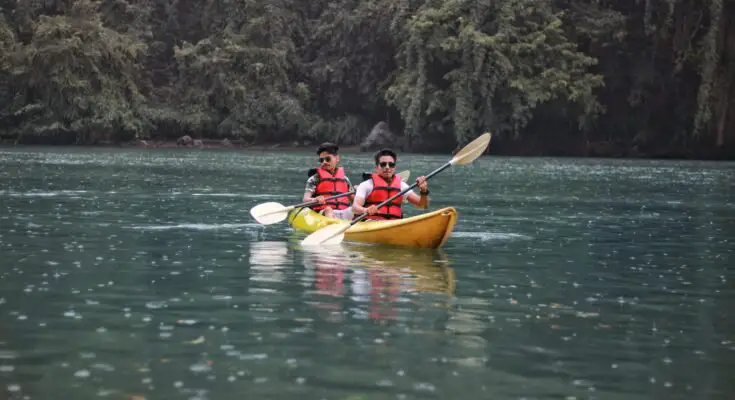

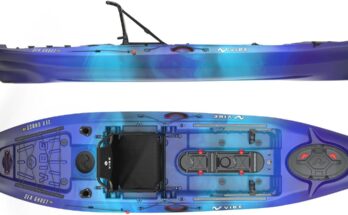

Please tell me more about this. May I ask you a question?
Thank you for sharing this article with me. It helped me a lot and I love it.